Maslenitsa
Maslenitsa (Russian: Мaсленица, Ukrainian: Масниця, Belarusian: Масленіца; also known as Butter Lady, Butter Week, Crepe week, or Cheesefare Week) is an Eastern Slavic religious and folk holiday, which has retained a number of elements of Slavic mythology in its ritual, celebrated during the last week before Great Lent, that is, the eighth week before Eastern Orthodox Pascha.
| Maslenitsa | |
|---|---|
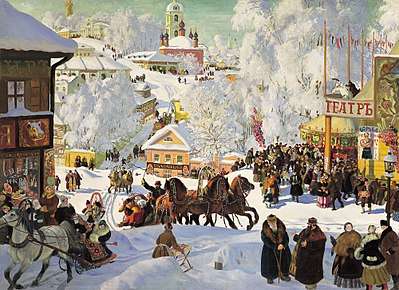 Maslenitsa, Boris Kustodiev, 1919 (Isaak Brodsky Museum, St. Petersburg) | |
| Also called | Butter Week, Crepe week, Cheesefare Week, Syropust, Kolodiya, Masnytsia |
| Observed by | Eastern Slavs mostly Russia, Ukraine and Belarus, as well as Russian, Ukrainian and Belarusian diaspora communities |
| Type | Ethnic |
| Significance | seeing off winter last week before Great Lent |
| Celebrations | making blini (pancakes), making visits, sleigh rides, dressing up, bonfires, snowball fights, the capture of the Snow Fortress, burning of the Maslenitsa Scarecrow In Ukraine and Belarus: eating varenyky with cottage cheese |
| 2019 date | 4 to 10 March |
| 2020 date | 24 February to 1 March |
| Frequency | annual |
| Related to | Mardi Gras |
The date of Maslenitsa changes every year depending on the date of the celebration of Easter. It corresponds to the Western Christian Carnival, except that Orthodox Lent begins on a Monday instead of a Wednesday, and the Orthodox date of Easter can differ greatly from the Western Christian date.
The traditional attributes of the Maslenitsa celebration are the scarecrow of Maslenitsa, sleigh rides, festivities. Russians bake pancakes and tortillas, Belarusians and Ukrainians bake dumplings, cheese cakes.
Traditions
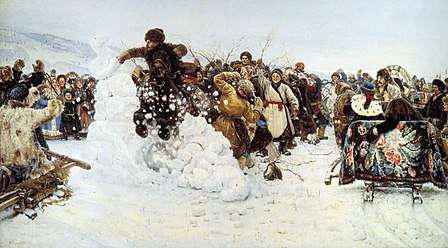
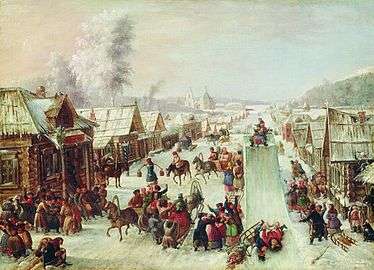
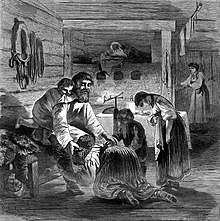
According to archeological evidence from 2nd century A.D. Maslenitsa may be the oldest surviving Slavic holiday.[1] Maslenitsa has its origins in the pagan tradition. In Slavic mythology, Maslenitsa is a sun-festival, personified by the ancient god Volos,[1] and a celebration of the imminent end of the winter. In the Christian tradition, Maslenitsa is the last week before the onset of Great Lent.[2]
During the week of Maslenitsa, meat is already forbidden to Orthodox Christians, and it is the last week during which eggs, milk, cheese and other dairy products are permitted, leading to its name of "Cheese-fare week" or "Crepe week". The most characteristic food of Maslenitsa is bliny - thin pancakes or crepes, made from the rich foods still allowed by the Orthodox tradition that week: butter, eggs and milk.
Since Lent excludes parties, secular music, dancing and other distractions from spiritual life, Maslenitsa represents the last chance to take part in social activities that are not appropriate during the more prayerful, sober and introspective Lenten season.[1]
In some regions, each day of Maslenitsa had its traditional activity. Monday may be the welcoming of “Lady Maslenitsa”. The community builds the Maslenitsa effigy out of straw (из соломы), decorated with pieces of rags, and fixed to a pole formerly known as Kostroma. It is paraded around and the first pancakes may be made and offered to the poor. On Tuesday, young men might search for a fiancée to marry after Lent. On Wednesday sons-in-law may visit their mother-in-law who has prepared pancakes and invited other guests for a party. Thursday may be devoted to outdoor activities. People may take off work and spend the day sledding, ice skating, snowball fights and with sleigh rides. On Friday sons-in-law may invite their mothers-in-law for dinner. Saturday may be a gathering of a young wife with her sisters-in-law to work on a good relationship.
Sunday of Forgiveness
The last day of Cheesefare Week is called "Forgiveness Sunday" (Прощёное Воскресенье). Relatives and friends ask each other for forgiveness and might offer them small presents. As the culmination of the celebration people gather to "strip Lady Maslenitsa of her finery" and burn her in a bonfire. Left-over pancakes may also be thrown into the fire and Lady Maslenitsa's ashes are buried in the snow to "fertilize the crops".[3]
At Vespers on Sunday evening, people may make a poklon (bow) before one another and ask forgiveness. Another name for Forgiveness Sunday is "Cheesefare Sunday", because for devout Orthodox Christians it is the last day on which dairy products may be consumed until Easter. Fish, wine and olive oil will also be forbidden on most days of Great Lent. The day following Cheesefare Sunday is called Clean Monday, because people have confessed their sins, asked forgiveness, and begun Great Lent with a clean slate.
Modern times
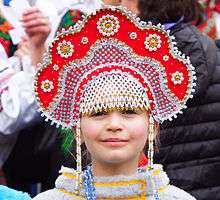
During Soviet times, Maslenitsa, like other religious holidays, was not celebrated officially. However, it was widely observed in families without its religious significance, as an opportunity to prepare crepes with all sorts of fillings and coverings and to eat and share them with friends. After the start of perestroika, the outdoor celebrations resumed, although they were seen by some as an artificial restoration of a dead tradition. As many Russians have returned to practicing Christianity, the tradition is still being revived.
With increasing secularization many Russians do not abstain from meat and Maslenitsa celebrations can be accompanied by shashlik vendors. Nevertheless, "meat still does not play a major role in the festivities".[1]
Many countries with a significant number of Russian immigrants consider Maslenitsa a suitable occasion to celebrate Russian culture, although the celebrations are usually reduced to one day and may not coincide with the date of the religious celebrations.
On 20 March 2017 the British tabloid newspaper Daily Mirror painted the Maslenitsa as a Hooligan training ground. One of the centuries-old tradition in this folk festival is “wall-to-wall” (‘stenka na stenku’, Ru) which is sparring between men dressed in traditional folk clothes. This tradition was wrongly represented by the Mirror in the pictures and text, labelled as violent acts and living in fear without giving context or any information about this Russian traditional festival at all. The Mirror article was titled “Russia's Ultra yobs infiltrated amid warnings England fans could be KILLED at World Cup.”, and received negative receptions from Russian media, also being described as fake news.[4][5][6][7]
See also
- Candlemas
- Slavic carnival
- Fašiangy (in the Slovakia)
- Rio Carnival (in the Brazil)
- Carnaval (in the Netherlands)
- Fat Thursday (in Poland)
- Mardi Gras (in other countries)
- Mărţişor (in Romania and Moldova)
- Marzanna (in Poland)
- Meteņi (in Latvia)
- Patras Carnival (in Greece)
- Tsiknopempti
- Shrove Tuesday or "Pancake Day" (in the United Kingdom and Ireland)
- Petrushka (ballet)
- Užgavėnės (in Lithuania)
- Farsang (Hungarian carnival)[8]
- Holi (in India)
- Shrovetide
References
- Maslenitsa, Blin! The Food and Celebration of the Russians Archived 2008-01-09 at the Wayback Machine By Josh Wilson, Newsletter, The School of Russian and Asian Studies, 9 March 2005.
- Maslenitsa by Margaret McKibben, Russian Folk Group of Seattle, WA, Seattle Community Network. undated.
- Ruslanguage School Moscow (22 February 2012). "Malenitsa, a Week of Festivities". Archived from the original on 1 February 2013. Retrieved 26 February 2015.
- "Brits scared about pancake battles Gazeta.ru". Gazeta.ru. 21 March 2017.
- "Fake news del Mirror, il Carnevale russo diventa allenamento per uccidere". Retrieved 21 March 2017.
- "UK tabloid distorts traditional Russian pancake festival into 'Ultra' football thug fights". Retrieved 21 March 2017.
- "Daily Mirror misleads with wrong pictures for article on football 'Ultras' in Russia". Retrieved 21 March 2017.
- Busójárás
External links
| Wikimedia Commons has media related to Maslenitsa. |
- Lives of the Saints The Orthodox Church in America, undated.
- Marks, Gil (2010). "Encyclopedia of Jewish Food". Wiley. pp. 56–58. Retrieved April 18, 2012. ISBN 9780470391303
